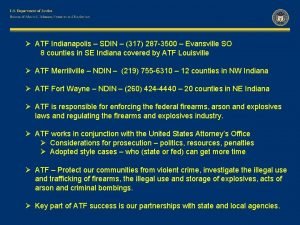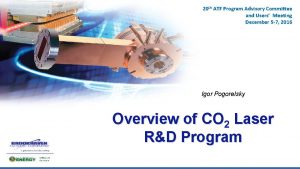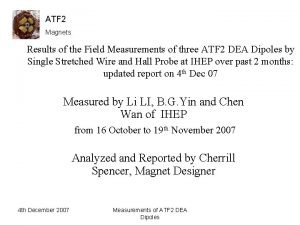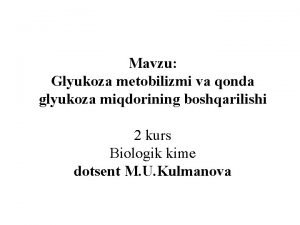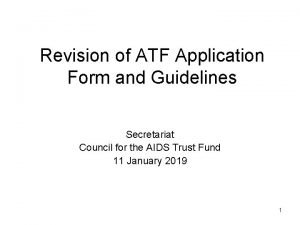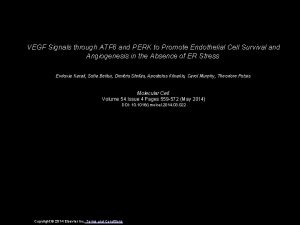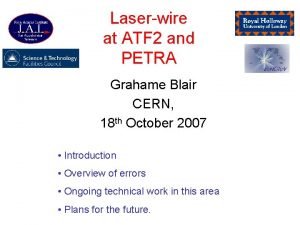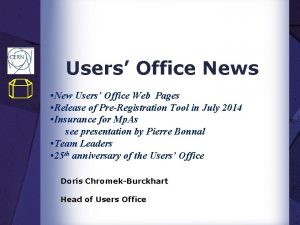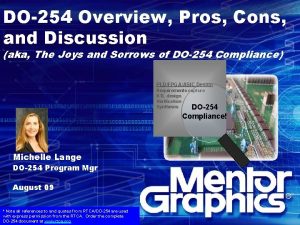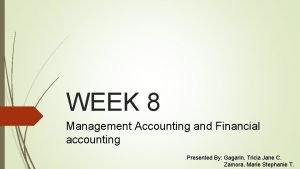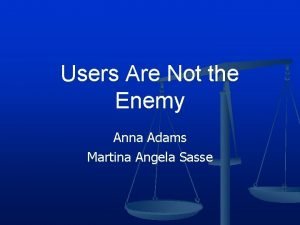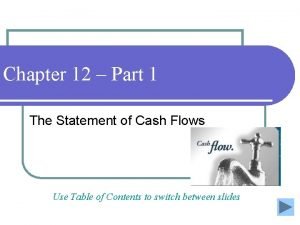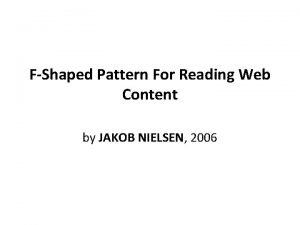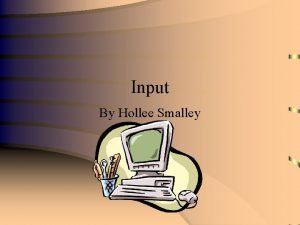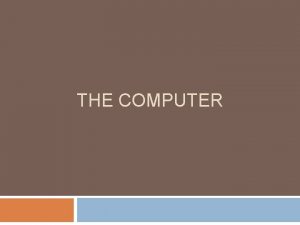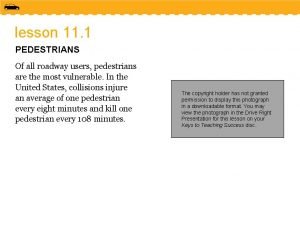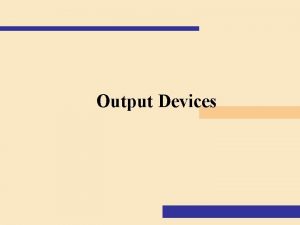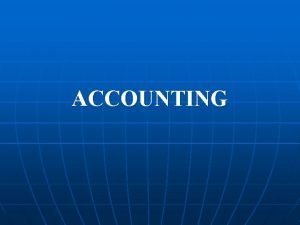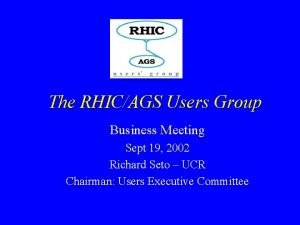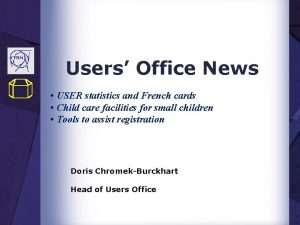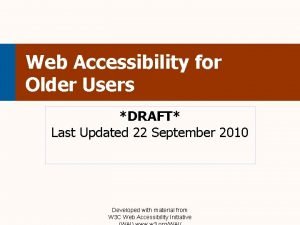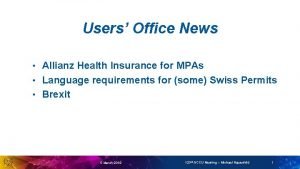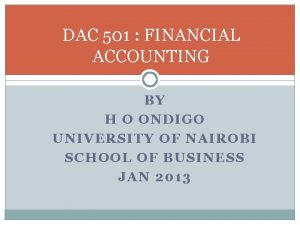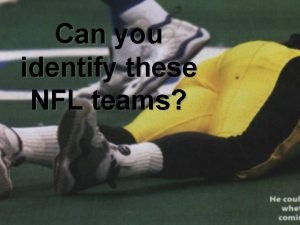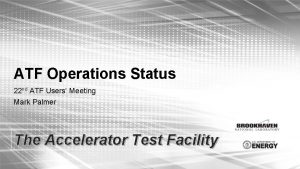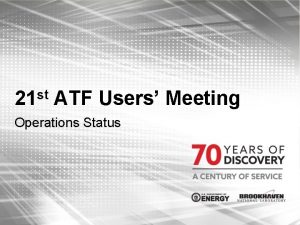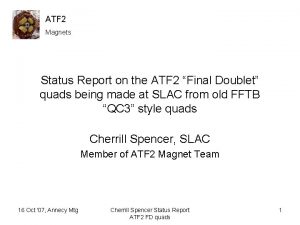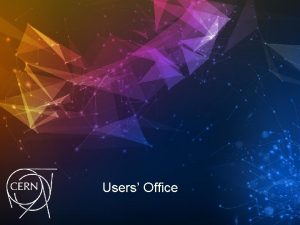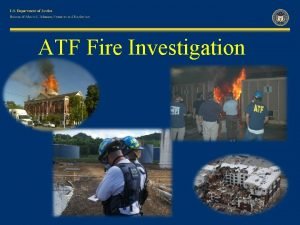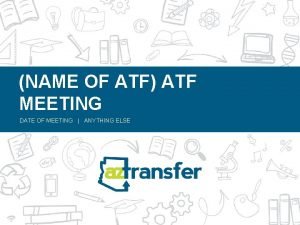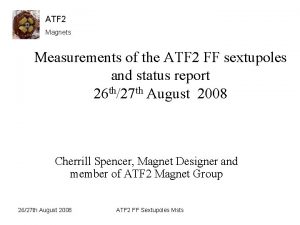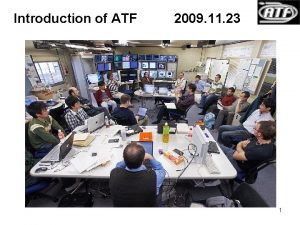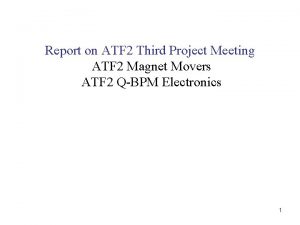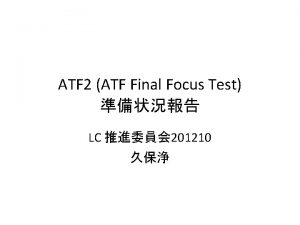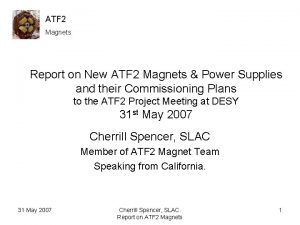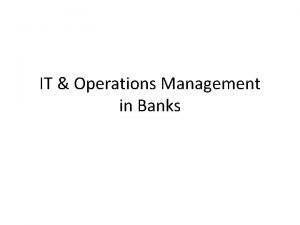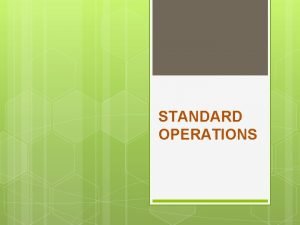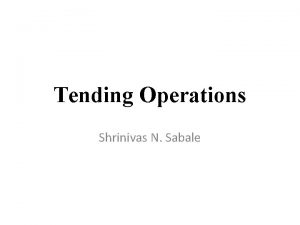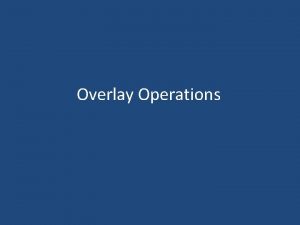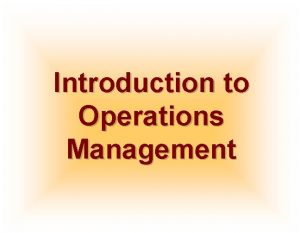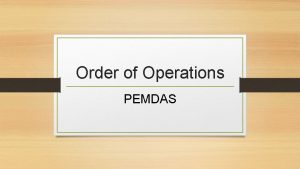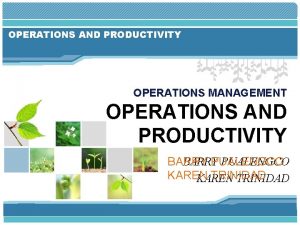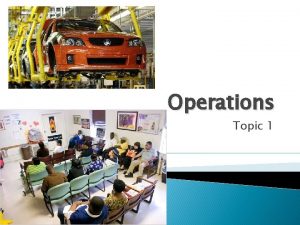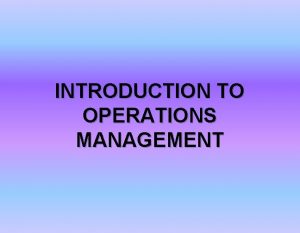ATF Operations Status 23 rd Annual ATF Users

























- Slides: 25

ATF Operations Status 23 rd Annual ATF Users’ Meeting (virtual) Mark Palmer December 7, 2020 The Accelerator Test Facility

A Special Thanks. . . • Program Advisory Committee: • Sandra Biedron (Chair), University of New Mexico • Jianming Cao, Florida State University • Jean-Pierre Delahaye, CERN • Louis Di. Mauro, Ohio State University • Ernest Fontes, Cornell University • Bjorn Manuel Hegelich, University of Texas at Austin • Patric Muggli, Max Planck Institute for Physics & CERN • Carl Schroeder*, Lawrence Berkeley National Lab • Craig Siders, Lawrence Livermore National Lab * Final year 2 Accelerator Test Facility

Outline FY 20 Recap Operations Status: What is available in 2021 Recap of User Resources and Responsibilities Availability User Activities Operations Summary Facility Updates COVID-19 Capability Operational Status Update Available Parameters Available Facilities Time Requests Beam Scheduling Run Reports Accelerator Test Facility

FY 20 Operations Recap 4 Accelerator Test Facility

Availability Planned Hours Delivered Hours % of Planned Hours Electron Beam 790 823 104% Laser (NIR + LWIR) 760 777 102% UED 950 741 78% Total 2500 2341 94% 2020 Resource 2021 Resource Planned Hours Electron Beam 750 Laser (NIR + LWIR) 750 UED 750 Total 2250 Accelerator Test Facility

User Activities Breakdown • UED set up for turn-key materials science operations • Accelerator focused experiments have the largest amount of setup time • Advanced accelerator experiments have a wide range of complex requirements. Accelerator Test Facility

FY 20 Hours Summary New Capability Being Brought Online Accelerator Test Facility

FY 20 Facility Updates Shielding wall Final amplifier LWIR path 8 Accelerator Test Facility

COVID-19 Impacts • User Operations interrupted in March • Prevented key experimental starts after last year’s Users’ Meeting • User hour impact mitigated by 3 effects: • Significant amount of user time provided at B 820 during FY 20 Q 1 and Q 2 to allow for a major upgrade down planned for Q 3 -Q 4 • Change in laser hour accounting (to include NIR user operations) • UED impacted by being on a complementary schedule to work at B 820 – loss of single largest run period in the March-May timeframe • Laboratory in Min Safe for ~3 months • ATF returned to limited operations on June 18 th • Rapidly returned UED to operations through end of year • Executed modifications to the CO 2 room in preparation for deploying the full in-vacuum transport upgrade to deliver high-power (5 TW) pulses to users a full upgrade not possible before summer 2021 • NOTE: Status report request includes COVID-19 impacts on users 9 Accelerator Test Facility

Operations Status 10 Accelerator Test Facility

Operational Status: Available User Time This plan is subject to considerable uncertainty depending on COVID-19 impacts BNL presently in a “Limited Operations” state. ATF has managed to bring the first few non-local users on-site during FY 21 Q 1. Accelerator Test Facility

Current Operational Status • Electron Beam • Operational in 15 -75 Me. V energy range • Replacement gun and linac klystrons performing well • X-band klystron repair funding has been received – long-lead repair, however • Significant impact on experiments needing the TCAV diagnostic • CO 2 Laser • >5 TW, 2 ps operation demonstrated at output of CPA • Presently certified for 2 TW delivery to user IPs • Higher powers require in-vacuum transport • Polarization rotator and circular polarization capability • Power limits observed for circular polarization • Major R&D program will continue to impact user operations next year • UED • Observed stable operation through summer 2020 • Validates improvements implemented in FY 10 • Operation up to 48 Hz delivered • Installation of OPA pump system delayed due to COVID-19 • NIR Systems • Ti: Sapphire laser system has been commissioned and operation verified to highest specified power • In-air transport of Stage I parameters to users operational Accelerator Test Facility

Capability Updates Planned in 2021 • Planned Updates: • Laser Capability • LWIR (CO 2) Laser System • In-Vacuum CPA and transport slated for deployment in summer 2021 • November Technical Review completed successfully – now preparing long-lead procurements • Expect user operations with >5 TW and <2 ps by late 2021 • Vacuum Transport updates will lay the foundation for further pulse compression upgrades in subsequent years • NIR Laser Systems • Nd: YAG • Second stage amplification to be added in 2021 • Ti: Sapphire • In-vacuum transport and vacuum compressor will enable Stage I and Stage II operating parameters in 2021 • UED (with UEM support) • OPA system to enable pump wavelengths in the mid- to long-wave IR • Scheduled for installation next week • Continued updates to the ATF pages and PASS system to reflect our current suite of capabilities Further Discussion During Friday Afternoon’s “Next Steps” Session 13 Accelerator Test Facility

Recap of User Resources and Responsibilities 14 Accelerator Test Facility

Electron Beam Requirements Parameter Units Typical Values Comments Beam Energy Me. V 50 -65 Full range is ~15 -75 Me. V with highest beam quality at nominal values Bunch Charge n. C 0. 1 -2. 0 Bunch length & emittance vary with charge Compression fs Down to 100 fs (up to 1 k. A peak current) A magnetic bunch compressor available to compress bunch down to ~100 fs. Beam quality is variable depending on charge and amount of compression required. NOTE: Further compression options are being developed to provide bunch lengths down to the ~10 fs level Transverse size at IP (s) mm 30 – 100 (dependent on IP position) Normalized Emittance mm 1 (at 0. 3 n. C) Variable with bunch charge Rep. Rate (Hz) Hz 1. 5 3 Hz also available if needed Trains mode --- Single bunch It is possible to achieve transverse sizes below 10 um with special permanent magnet optics. Multi-bunch mode available. Trains of 24 or 48 ns spaced bunches. Requested Values

CO 2 Laser Requirements Configuration Parameter Units Typical Values Wavelength mm 9. 2 Peak Power GW ~3 Pulse Mode --- Single Pulse Length ps 2 Pulse Energy m. J 6 M 2 --- ~1. 5 Repetition Rate Hz 1. 5 Polarization --- Linear CO 2 CPA Beam Wavelength mm 9. 2 Note that delivery of full power pulses to the Experimental Hall is presently limited to Beamline #1 only. Peak Power TW 2 Pulse Mode --- Single Pulse Length ps 2 Pulse Energy J ~5 M 2 --- ~2 Repetition Rate Hz 0. 05 CO 2 Regenerative Amplifier Beam Polarization Linear Comments Wavelength determined by mixed isotope gain media 3 Hz also available if needed Circular polarization available at slightly reduced power Wavelength determined by mixed isotope gain media ~5 TW operation is planned for FY 21 (requires further in -vacuum transport upgrade). A 3 -year development effort to achieve >10 TW and deliver to users is in progress. Maximum pulse energies of >10 J will become available in FY 20 Adjustable linear polarization along with circular polarization will become available in FY 20 Requested Values

Near IR Experimental Laser Requirements Ti: Sapphire Laser System Units Stage I Values Stage II Values Central Wavelength nm 800 FWHM Bandwidth nm 20 13 Compressed FWHM Pulse Width fs <55 <75 Chirped FWHM Pulse Width ps 50 Chirped Energy m. J >30 200 Compressed Energy m. J >14 100 Energy to Experiments m. J >10 >80 Power to Experiments GW >250 >1067 Nd: YAG Laser System Units Typical Values 2021 Modifications Wavelength nm 1064 Energy m. J 5 100 Pulse Width ps 14 <20 Wavelength nm 532 Energy m. J 0. 5 Pulse Width ps 10 Comments Requested Values Stage I parameters have been delivered, while Stage II parameters will be available for user experiments once our vacuum transport installation is complete (now planned for FY 21 after COVID-19 delays) Transport of compressed pulses will initially include a very limited number of experimental interaction points. Please consult with the ATF Team if you need this capability. Comments Single pulse Frequency doubled Requested Values

Special Equipment Requirements and Hazards • Electron Beam • Please indicate any special equipment that you expect to need, including (but not limited to) the transverse deflecting cavity, shaped bunch using mask technique, plasma capillary discharge system, bolometer/interferometer setup etc. : • CO 2 Laser • Please note any specialty laser configurations required here: • Ti: Sapphire and Nd: YAG Lasers • Please note any specialty non-CO 2 laser configurations required here: • Hazards & Special Installation Requirements • • • Large installation (chamber, insertion device, etc. ): Cryogens: Introducing new magnetic elements: Introducing new materials into the beam path: Any other foreseeable beam line modifications: Accelerator Test Facility

Six Available IPs • FEL room – high power CO 2 delivered to ion chamber with gas jet capability • BL 1 – 3 chambers. • IGS chamber for electron beam-only experiments • LWFA chamber for laser–ebeam experiments plus gas jet capability • Compton chamber for laser-ebeam interaction • BL 2 – 1 chamber + 1 insertion device IP • Plasma chamber with capillary discharge capability and laser delivery • Designated area for wiggler structures etc. with laser interaction capability • Laser delivery to both IPs at reduced power – vacuum transport does not extend beyond BL 1 • Deflecting cavity diagnostic Accelerator Test Facility

UED Special Equipment Requirements and Hazards • Indicate whether your experiment requires UED or UEM beams • User Sample and Setup • Please indicate any special equipment that you expect to need bolometer/interferometer setup etc. : • Pump Laser Requirements • Please note any special pump laser requirements here: • Hazards & Special Installation Requirements • • • Large installation (chamber, insertion device, etc. ): Cryogens: Introducing new magnetic elements: Introducing new materials into the beam path: Any other foreseeable beam line modifications: Accelerator Test Facility

Time Request For new experiments and experiments continuing into 2020, a time request must be submitted at pass. bnl. gov ATF Proposal PI Name Accelerator Test Facility

Beam Scheduling and Planning • Check the online schedule from the Operations tab on the ATF homepage • Submit a beam time request https: //surveys. external. bnl. gov/n/ATFShift. Request. aspx • Check that your experimental safety review is in place, email Karl Kusche (kusche@bnl. gov) • Submit installation and run plans to atf@bnl. gov • Read the Users’ Place section of the ATF website • Attend the 9 am Monday planning meeting, during your run, to coordinate technical support and experiment requirements Accelerator Test Facility

Run Reports • The lead experimenter should attend the ATF weekly meeting at 4 pm each Friday, during their run, to report that week’s progress. • PI’s should inform the ATF if they wish to designate a second person to be the main point-of-contact or lead experimenter • Submit an end-of-run survey form after finishing run at https: //surveys. external. bnl. gov/n/ATFUsers. Run. Report. aspx Accelerator Test Facility

Questions? Accelerator Test Facility

25
 Annual status of education report
Annual status of education report Atf indianapolis
Atf indianapolis Atf
Atf Deltb
Deltb Atf masalalar yechish usullari
Atf masalalar yechish usullari Atf application form
Atf application form Atf hand signals
Atf hand signals Atf
Atf Cern users office
Cern users office Do254
Do254 External users of accounting information
External users of accounting information Nnnn enemy
Nnnn enemy The statement of cash flows helps users
The statement of cash flows helps users F reading pattern
F reading pattern Vinput leah
Vinput leah Allows rapid entry of text by experienced users
Allows rapid entry of text by experienced users Are the most vulnerable roadway users
Are the most vulnerable roadway users Output devices for physically challenged users
Output devices for physically challenged users The language of business is known as
The language of business is known as Operating activities vs investing activities
Operating activities vs investing activities Rhic ags users meeting 2020
Rhic ags users meeting 2020 Users office cern
Users office cern Web accessibility for older users
Web accessibility for older users Allianz health insurance switzerland
Allianz health insurance switzerland 5 users of accounting information
5 users of accounting information Six shooters nfl team
Six shooters nfl team

